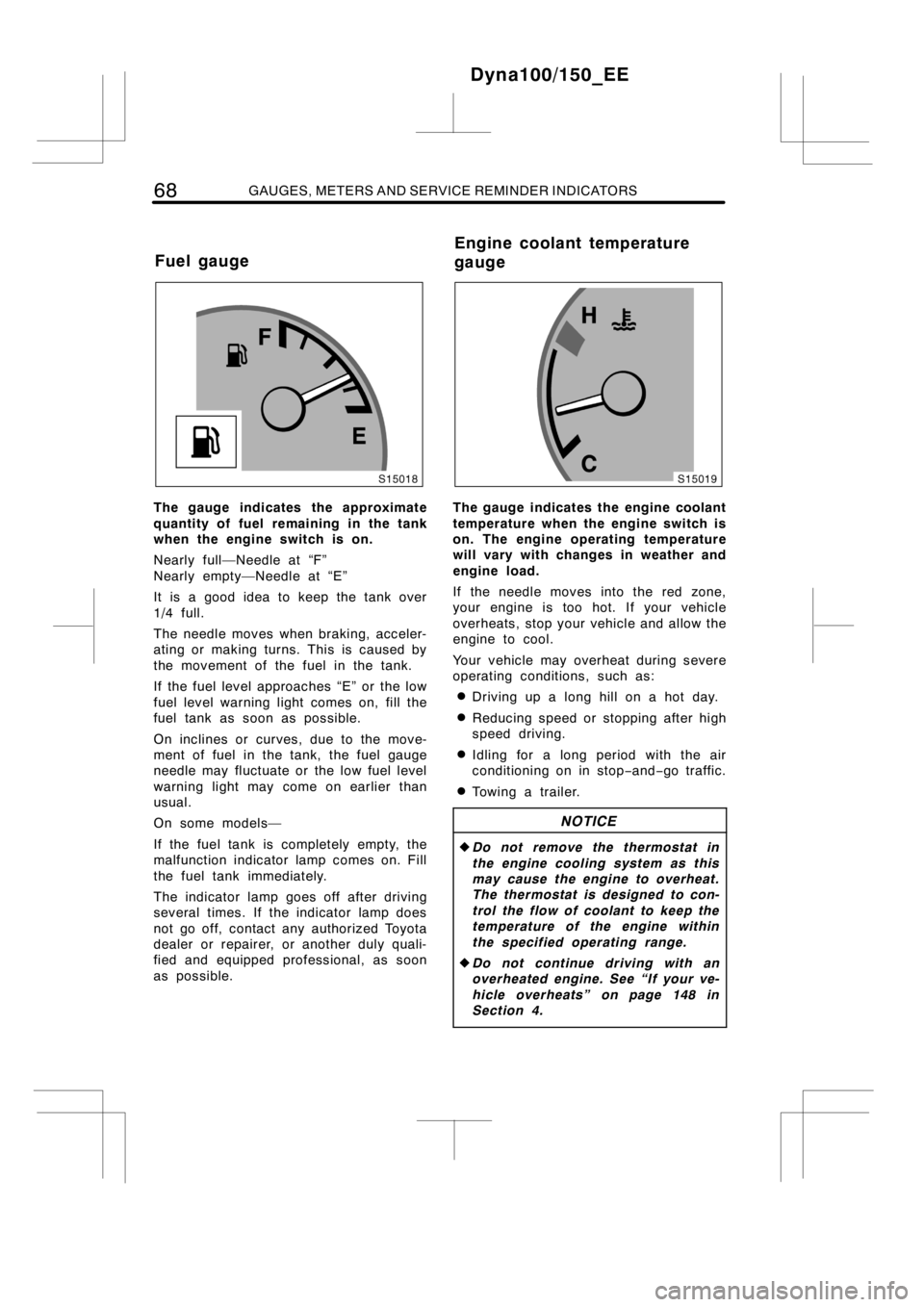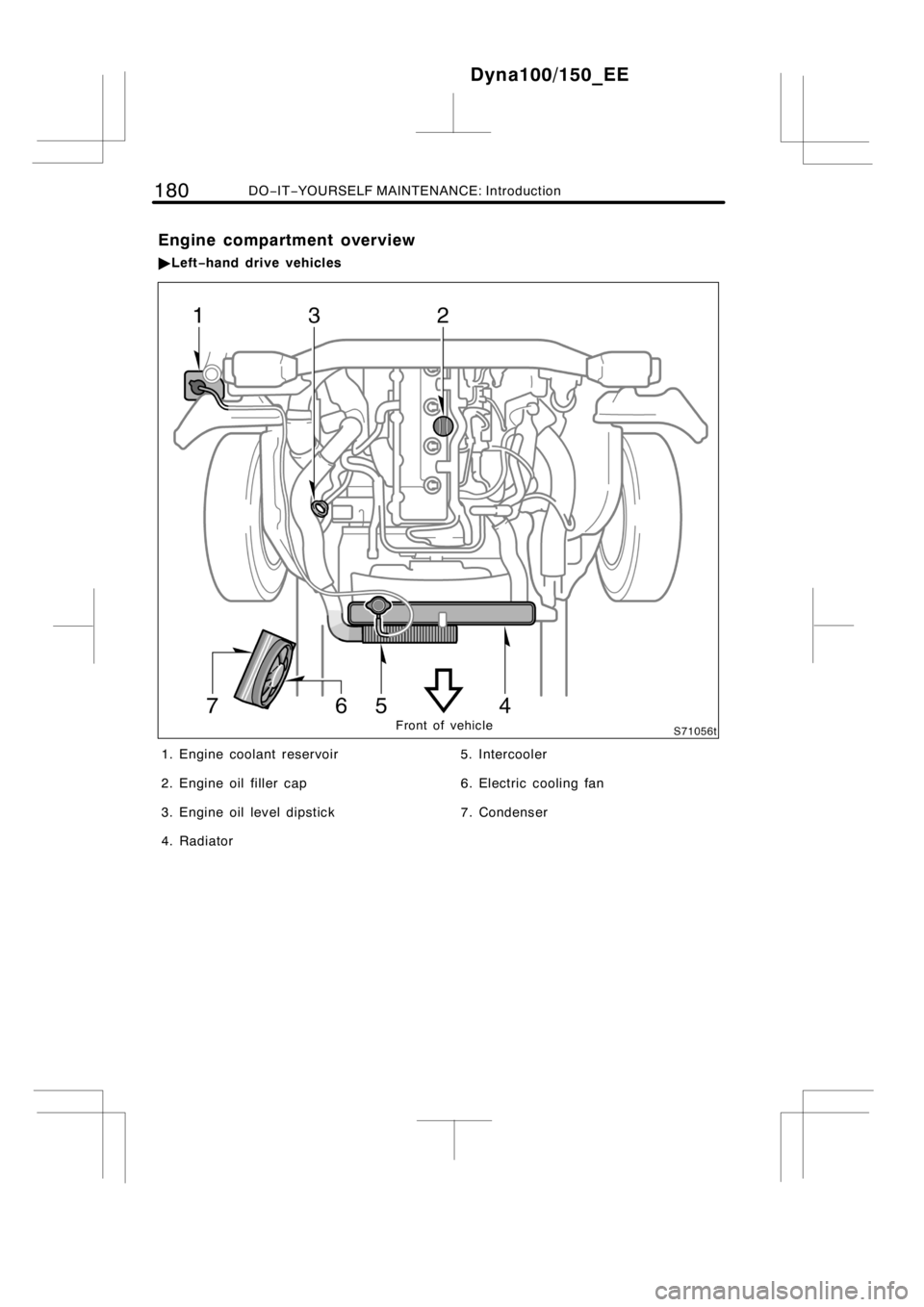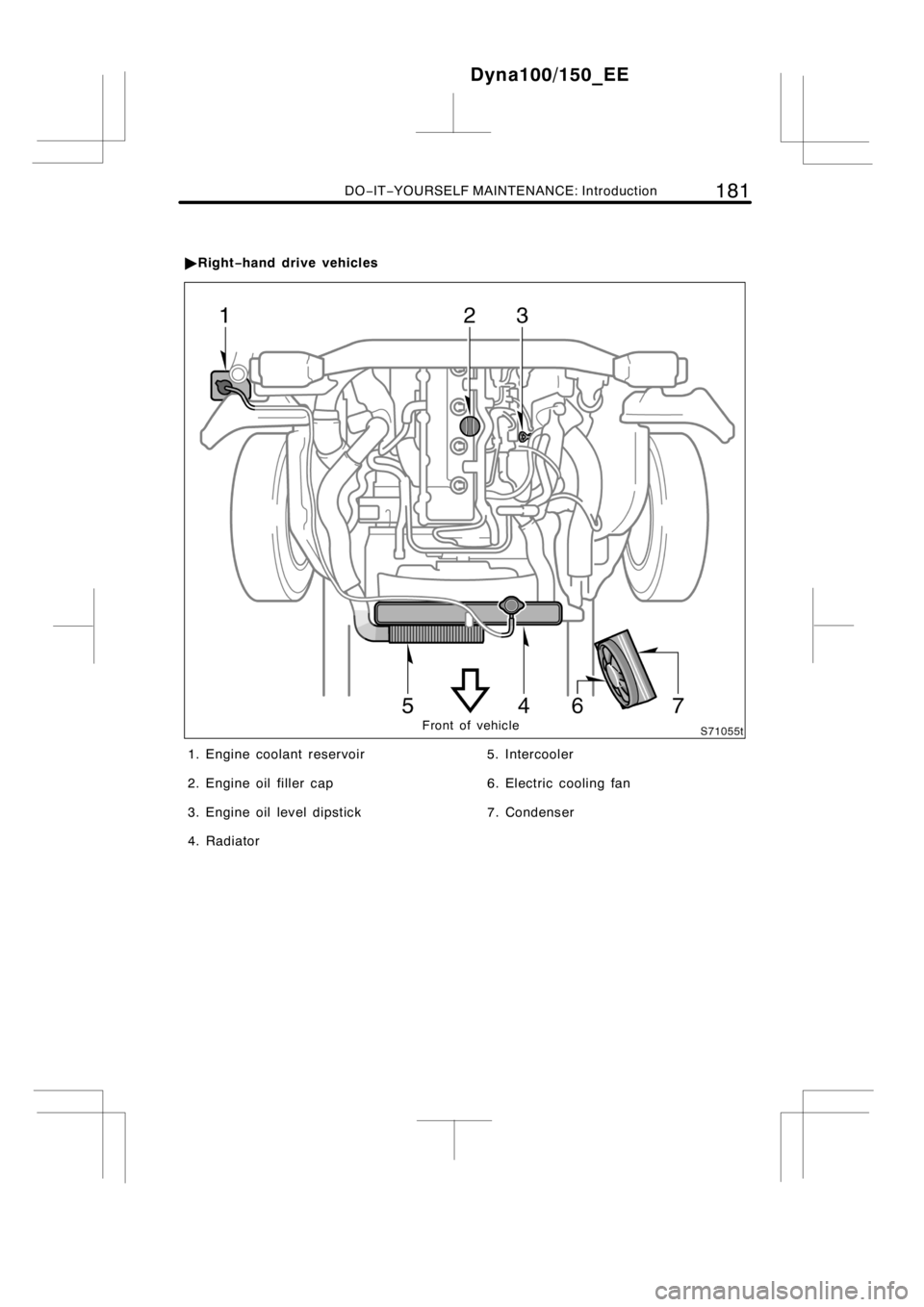2014 TOYOTA DYNA 100/150 cooling
[x] Cancel search: coolingPage 74 of 232

68GAUGES, METERS AND SERVICE REMINDER INDICATORS
The gauge indicates the approximate
quantity of fuel remaining in the tank
when the engine switch is on.
Nearly full—Needle at “F”
Nearly empty—Needle at “E”
It is a good idea to keep the tank over
1/4 full.
The needle moves when braking, acceler-
ating or making turns. This is caused by
the movement of the fuel in the tank.
If the fuel level approaches “E” or the low
fuel level warning light comes on, fill the
fuel tank as soon as possible.
On inclines or curves, due to the move-
ment of fuel in the tank, the fuel gauge
needle may fluctuate or the low fuel level
warning light may come on earlier than
usual.
On some models—
If the fuel tank is completely empty, the
malfunction indicator lamp comes on. Fill
the fuel tank immediately.
The indicator lamp goes off after driving
several times. If the indicator lamp does
not go off, contact any authorized Toyota
dealer or repairer, or another duly quali-
fied and equipped professional, as soon
as possible.The gauge indicates the engine coolant
temperature when the engine switch is
on. The engine operating temperature
will vary with changes in weather and
engine load.
If the needle moves into the red zone,
your engine is too hot. If your vehicle
overheats, stop your vehicle and allow the
engine to cool.
Your vehicle may overheat during severe
operating conditions, such as:
DDriving up a long hill on a hot day.
DReducing speed or stopping after high
speed driving.
DIdling for a long period with the air
conditioning on in stop−and−go traffic.
DTowingatrailer.
NOTICE
zDo not remove the thermostat in
the engine cooling system as this
may cause the engine to overheat.
The thermostat is designed to con-
trol the flow of coolant to keep the
temperature of the engine within
the specified operating range.
zDo not continue driving with an
overheated engine. See “If your ve-
hicle overheats” on page 148 in
Section 4.
Dyna100/150_EE
Fuel gaugeEngine coolant temperature
gauge
Page 96 of 232

90AIR CONDITIONING SYSTEM
Air conditioning
For best results, set controls to:
Fan speed—Any setting except “OFF”
Temperature—To w a r d sCOLD
(blue zone)
Air intake—FRESH(outside air)
Air flow—PANEL
Air conditioning—ON
DFor quick cooling, move the air intake
selector to recirculate for a few min-
utes.
Ventilation
For best results, set controls to:
Fan speed—Any setting except “OFF”
Temperature—To w a r d sCOLD
(blue zone)
Air intake—FRESH(outside air)
Air flow—PANEL
Air conditioning—OFF
Defogging
The inside of the windshield
For best results, set controls to:
Fan speed—Any setting except “OFF”
Temperature—To w a r d sWARM(red
zone) to heat;COLD
(blue zone) to cool
Air intake—FRESH(outside air)
Air flow—WINDSHIELD
Air conditioning—ON
DOn humid days, do not blow cold air
on the windshield—the difference be-
tween the outside and inside tempera-
tures could make the fogging worse.Defrosting
The outside of the windshield
For best results, set controls to:
Fan speed—Any setting except “OFF”
Temperature—To w a r d sWARM
(red zone)
Air intake—FRESH(outside air)
Air flow—WINDSHIELD
DTo heat the vehicle interior while de-
frosting the windshield, choose
floor/windshield air flow.
Dyna100/150_EE
Page 120 of 232

11 4INFORMATION BEFORE DRIVING YOUR TOYOTA
CAUTION
DExhaust gases include harmful car-
bon monoxide (CO) that is colorless
and odorless. Inhaling exhaust
gases may lead to death or a seri-
ous health hazard.
DThe exhaust should be checked
occasionally. If there is a hole or
crack caused by corrosion, damage
to a joint or abnormal exhaust
noise, be sure to have the vehicle
inspected and repaired by any
authorized Toyota dealer or repairer,
or another duly qualified and
equipped professional. Failure to do
so may allow exhaust gases to
enter the vehicle, resulting in death
or a serious health hazard.
DIf the vehicle is in a poorly venti-
lated area, turn the engine off. In a
closed area, such as a garage, ex-
haust gases may collect and enter
the vehicle. This may lead to death
or a serious health hazard.
DDo not remain for a long time in a
parked vehicle with the engine run-
ning. If it is unavoidable, however,
do so only in an unconfined area
and adjust the heating or cooling
system to force outside air into the
vehicle.
DIf the smell of exhaust is noticed
inside the vehicle, open the win-
dows. Large amounts of exhaust in
the vehicle can cause driver drowsi-
ness and an accident, resulting in
death or a serious health hazard.
Have the vehicle inspected by any
authorized Toyota dealer or repairer,
or another duly qualified and
equipped professional immediately.
DDo not leave the engine running in
an area with snow build−up, or
where it is snowing. If snowbanks
build up around the vehicle while
the engine is running, exhaust
gases may collect and enter the ve-
hicle. This may lead to death or a
serious health hazard.
DWhen taking a nap in the vehicle,
always turn the engine off. Other-
wise, you may accidentally move
the shift lever or depress the accel-
erator pedal, which could cause an
accident or fire due to engine over-
heating. Additionally, if the vehicle
is parked in a poorly ventilated
area, exhaust gases may collect and
enter the vehicle, leading to death
or a serious health hazard.
DToyota does not recommend occu-
pying the rear cargo area when it
is fitted with a slide−in camper,
camper shell or other type cover
while the engine is running. This
caution applies to both driving and
stopped or parked situations with
the engine running. Particular care
should be taken to prevent exhaust
gases from entering camper bodies,
trailers or other enclosures on or
around your vehicle. If exhaust
fumes are detected, open all win-
dows and thoroughly ventilate the
area.
Dyna100/150_EE
Engine exhaust cautions
Page 121 of 232

INFORMATION BEFORE DRIVING YOUR TOYOTA11 5
FUNCTIONS OF ENGINE OIL
Engine oil has the primary functions of
lubricating and cooling the inside of the
engine, and plays a major role in main-
taining the engine in proper working order.
ENGINE OIL CONSUMPTION
It is normal that an engine should con-
sume some engine oil during normal
engine operation. The causes of oil
consumption in a normal engine are as
follows.
DOil is used to lubricate pistons, piston
rings and cylinders. A thin film of oil
is left on the cylinder wall when a pis-
ton moves downwards in the cylinder.
High negative pressure generated when
the vehicle is decelerating sucks some
of this oil into the combustion chamber.
This oil as well as some part of the oil
film left on the cylinder wall is burned
by the high temperature combustion
gases during the combustion process.
DOil is also used to lubricate the stems
of the intake valves. Some of this oil
is sucked into the combustion chamber
together with the intake air and is
burned along with the fuel. High tem-
perature exhaust gases also burn the
oil used to lubricate the exhaust valve
stems.
The amount of engine oil consumed de-
pends on the viscosity of the oil, the
quality of the oil and the conditions the
vehicle is driven under.
More oil is consumed by high−speed driv-
ing and frequent acceleration and decel-
eration.
A new engine consumes more oil, since
its pistons, piston rings and cylinder walls
have not become conditioned.
Oil consumption:Max. 1.0 L per 1000
km (1.1 qt./600 miles, 0.9 Imp. qt./600
miles)When judging the amount of oil con-
sumption, note that the oil may become
diluted and make it difficult to judge
the true level accurately.
As an example, if a vehicle is used for
repeated short trips, and consumes a nor-
mal amount of oil, the dipstick may not
show any drop in the oil level at all, even
after 1000 km (600 miles) or more. This
is because the oil is gradually becoming
diluted with fuel or moisture, making it
appear that the oil level has not changed.
The diluting ingredients evaporate out
when the vehicle is then driven at high
speeds, as on an expressway, making it
appear that oil is excessively consumed
after driving at high speeds.
IMPORTANCE OF ENGINE OIL LEVEL
CHECK
One of the most important points in prop-
er vehicle maintenance is to keep the en-
gine oil at the optimum level so that oil
function will not be impaired. Therefore, it
is essential that the oil level be checked
regularly. Toyota recommends that the oil
level be checked every time you refuel
the vehicle.
NOTICE
Failure to check the oil level regularly
could lead to serious engine trouble
due to insufficient oil.
For detailed information on oil level check,
see “Checking the engine oil level” on
page 188 in Section 7−2.
Dyna100/150_EE
Facts about engine oil
consumption
Page 154 of 232

148IN CASE OF AN EMERGENCY
If your engine coolant temperature
gauge indicates overheating, if you ex-
perience a loss of power, or if you hear
a loud knocking or pinging noise, the
engine has probably overheated. You
should follow this procedure...
1. Pull safely off the road, stop the ve-
hicle, and turn on your emergency
flashers. Put the transmission in neu-
tral and apply the parking brake. Turn
off the air conditioning if it is being
used.
2. If coolant or steam is boiling out of the
radiator or reservoir, stop the engine.
Wait until the steam subsides before
opening the engine access hole cover
or tilting the cab. If there is no coolant
or steam boiling over, leave the engine
running and make sure the electric
cooling fan is operating. If it is not,
turn the engine switch off.
CAUTION
To help avoid serious injury, keep the
engine access hole cover closed or
the cab lowered until there is no
steam. Escaping steam or coolant is
a sign of very high pressure.
3. Visually check to see if the engine
drive belt (fan belt) is broken or loose.
Look for obvious coolant leaks from the
radiator, hoses, and under the vehicle.
However, note that water draining from
the air conditioning is normal if it has
been used.
CAUTION
When the engine is running, keep
hands and clothing away from the
moving fan and engine drive belts.
4. If the engine drive belt is broken or the
coolant is leaking, stop the engine im-
mediately. Call any authorized Toyota
dealer or repairer, or another duly qual-
ified and equipped professional, for as-
sistance.
5. If the engine drive belt is O.K. and
there are no obvious leaks, you may
help the engine cool down more quickly
by running it at about 1500 rpm for a
few minutes with the accelerator pedal
lightly depressed.
6. Check the coolant reservoir. If it is dry,
add coolant to the reservoir while the
engine is running. Fill it about half full.
For the coolant type, see “Coolant type
selection” on page 191 in Section 7−2.
CAUTION
Do not attempt to remove the radiator
cap when the engine and radiator are
hot. Serious injury could result from
scalding hot fluid and steam blown
out under pressure.
7. After the engine coolant temperature
has cooled to normal, again check the
coolant level in the reservoir. If neces-
sary, bring it up to half full again.
Serious coolant loss indicates a leak in
the system. You should have it
checked as soon as possible at any
authorized Toyota dealer or repairer, or
another duly qualified and equipped
professional.
Dyna100/150_EE
If your vehicle overheats
Page 183 of 232

MAINTENANCE REQUIREMENTS177
Note, however, that some maintenance
tasks require special tools and skills.
These are best performed by qualified
technicians. Even if you’re an experienced
do−it−yourself mechanic, we recommend
that repairs and maintenance be con-
ducted by an authorized Toyota dealer or
repairer, or another duly qualified and
equipped professional. Any authorized
Toyota dealer or repairer will keep a
record of maintenance, which could be
useful should you ever require Warranty
Service. Should you choose to select a
qualified and equipped professional other
than an authorized Toyota repairer to
service or maintain your vehicle, we
recommend that you request that a record
of maintenance be kept.
The service interval for scheduled main-
tenance is determined by the odometer
reading or time interval, whichever
comes first, shown in the schedule.
Rubber hoses (for cooling and heater
system, brake system and fuel system)
should be inspected by a qualified tech-
nician in accordance with the Toyota
maintenance schedule.
They are particularly important mainte-
nance items. Have any deteriorated or
damaged hoses replaced immediately.
Note that rubber hoses will deteriorate
with age, resulting in swelling, chafing or
cracks.Be on the alert for changes in perfor-
mance, sounds, and visual tip−offs that
indicate service is needed. Some impor-
tant clues are as follows:
DEngine missing, stumbling, or pinging
DAppreciable loss of power
DStrange engine noises
DA leak under the vehicle (However, wa-
ter dripping from the air conditioning
after use is normal.)
DChange in exhaust sound (This may
indicate a dangerous carbon monoxide
leak. Drive with the windows open and
have the exhaustsystem checked im-
mediately.)
DFlat−looking tire; excessive tire squeal
when cornering; uneven tire wear
DVehicle pulls to one side when driving
straight on a level road
DStrange noises related to suspension
movement
DLoss of brake effectiveness; spongy
feeling brake or clutch pedal; pedal al-
most touches floor; vehicle pulls to one
side when braking
DEngine coolant temperature continually
higher than normal
If you notice any of these clues, take your
vehicle to any authorized Toyota dealer or
repairer, or another duly qualified and
equipped professional, as soon as pos-
sible. It probably needs adjustment or re-
pair.
CAUTION
Do not continue driving with the ve-
hicle unchecked. It could result in se-
rious vehicle damage and possibly se-
rious injury.
Dyna100/150_EE
Does your vehicle need
repairing?
Page 186 of 232

180DO−IT−YOURSELF MAINTENANCE: Introduction
Front of vehicle
1. Engine coolant reservoir
2. Engine oil filler cap
3. Engine oil level dipstick
4. Radiator5. Intercooler
6. Electric cooling fan
7. Condenser
Dyna100/150_EE
Engine compartment overview
"Left−hand drive vehicles
Page 187 of 232

DO−IT−YOURSELF MAINTENANCE: Introduction181
Front of vehicle
1. Engine coolant reservoir
2. Engine oil filler cap
3. Engine oil level dipstick
4. Radiator5. Intercooler
6. Electric cooling fan
7. Condenser
Dyna100/150_EE
"Right−hand drive vehicles